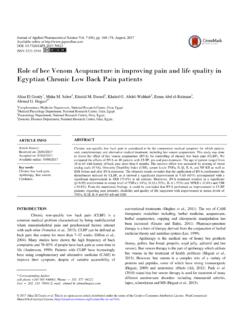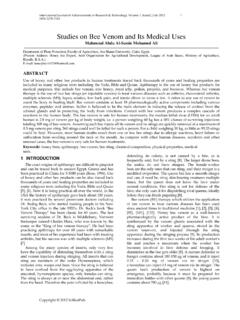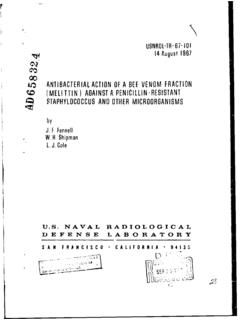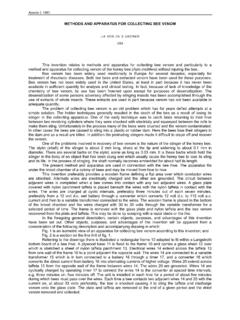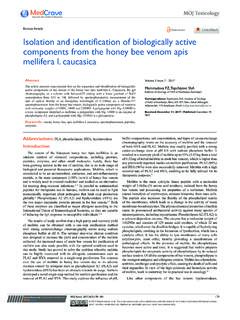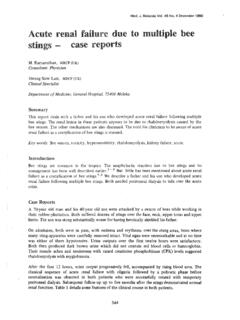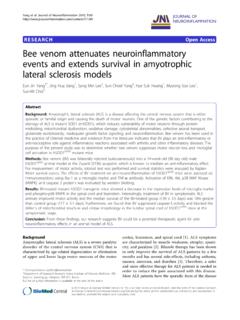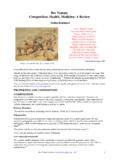Transcription of Allergy to Bee Venom in Beekeepers in Germany - …
1 Bee Venom Allergy in Beekeepers J Investig Allergol Clin Immunol 2008; Vol. 18(2): 100-105 2008 Esmon PublicidadORIGINAL ARTICLEA llergy to Bee Venom in Beekeepers in GermanyK M nstedt,1 M Hellner,1 D Winter,2 R von Georgi 3,41 Department of Obstetrics and Gynecology, University Hospital Giessen and Marburg, Justus Liebig University, Giessen, Germany2 Medical Clinic and Policlinic 3, University Hospital Giessen and Marburg, Justus Liebig University, Giessen, Germany3 Institute of Medical Psychology and Sociology, Justus-Liebig University, Giessen, Germany4 Institute of Music Science, Justus-Liebig-University, Giessen, Germany AbstractObjective.
2 The aim of this study was to determine the incidence of bee Venom Allergy in German Beekeepers , to explore risk factors for bee Venom Allergy in this group, and to determine which factors best predicted severe : A questionnaire incorporating 2 instruments on Beekeepers physical and mental health and working practice was included in 3 German beekeeping journals. A reference group also completed the questionnaire. Simple descriptive methods, bivariate correlation, cross-tabulation, 1-way analysis of variance, and stepwise discriminant analysis were used to analyze : Altogether, 1053 questionnaires were returned.
3 No signifi cant differences were seen between the 2 groups. The mean number of bee stings annually was (median, 30; range, 0 1000). Overall, 46 ( %) Beekeepers reported systemic reactions to bee stings, 797 ( %) had mild local reactions, and 196 ( %) had no reactions. The study confi rmed several risk factors. These were, in descending order of importance, symptoms of upper respiratory Allergy while working on the hive, presence of other allergies, time spent as a beekeeper, and more severe nonallergic reactions to bee stings in springtime. These factors identifi ed Beekeepers at risk of allergic reactions to bee Venom in % of cases.
4 Our results also showed an association between Allergy and emotional instability. Risk management in allergic Beekeepers was not good. Conclusion: The results of this study will help to identify Beekeepers at risk of systemic reactions to bee stings and to inform them about the dangers of bee Venom Allergy . Key words: Bee Venom . Allergy . Beekeeper. Beekeeping. ResumenObjetivo: El objetivo de este estudio fue determinar la incidencia de la alergia al veneno de abeja entre los apicultores alemanes para explorar los factores de riesgo de la alergia al veneno de abeja en este grupo y precisar qu factores eran los mejores para pronosticar las reacciones todos: Se adjunt un cuestionario que inclu a 2 instrumentos sobre la salud f sica y mental y la pr ctica del trabajo de apicultor en 3 revistas de apicultura de Alemania.
5 Tambi n complet el cuestionario un grupo de referencia. Para analizar los datos se utilizaron m todos descriptivos simples, la correlaci n entre variables, las tablas de contingencia, el an lisis de la varianza de un factor (ANOVA) y el an lisis discriminante paso a paso. Resultados: En conjunto, se devolvieron 1053 cuestionarios. No se observaron diferencias signifi cativas entre los dos grupos. La media anual de picaduras de abeja fue de 57,8 (media, 30; rango, 0 1000). En general, 46 (4,4 %) apicultores notifi caron reacciones sist micas a las picaduras de abeja, 797 (75,6 %) presentaron reacciones locales leves y 196 (18,6 %) no tuvieron ninguna reacci n.
6 De este modo, el estudio confi rm diversos factores de riesgo, que correspondieron, en orden de importancia descendiente, a s ntomas de alergia de las v as respiratorias altas mientras trabajaban en la colmena, a la presencia de otras alergias, al tiempo que llevaban trabajando de apicultores y a reacciones no al rgicas a las picaduras de abeja m s graves en primavera. Estos factores identifi caron a los apicultores que presentaban riesgo de tener reacciones al rgicas al veneno de la abeja en un 85,2 % de los casos en los que se sospechaba que podr a aparecer una reacci n al rgica.
7 Nuestros resultados tambi n mostraron una relaci n entre la alergia y el desequilibrio emocional. Las pr cticas arriesgadas en los apicultores al rgicos fueron n: Los resultados de este estudio ser n de gran ayuda para identifi car los apicultores que presentan riesgo de padecer reacciones sist micas a las picaduras de abeja y para informarles de los riesgos que conlleva la alergia al veneno de abeja. Palabras clave: Veneno de abeja. Alergia. Apicultor. Investig Allergol Clin Immunol 2008; Vol. 18(2): 100-105 2008 Esmon PublicidadK M nstedt, et al101 IntroductionThe reported prevalence of systemic allergic reactions to bee Venom in the general population ranges from to , and annual mortality due to bee stings ranges from to per million inhabitants [1].
8 These wide variations can largely be explained by climatic differences. In warm climates, bees are active throughout the year and are considered to be more aggressive, whereas in colder climates they are active and numerous only in late spring and summer [2]. According to studies from Italy [3], France [4], and Turkey [5], the likelihood of someone being stung by a bee at least once during his or her lifetime ranges from 55% to 95%. Beekeepers have a much higher probability of being stung than others in the population and they also encounter other antigens associated with beekeeping, including bee Venom , dust from the bee hive containing parts of bees and parasites, and propolis, the resinous substance collected by bees to construct and mend their hives.
9 The greater prevalence of various allergies in Beekeepers means that they are considered a high risk group [6]. Studies suggest that between 17% and 43% of Beekeepers are allergic to bee Venom [6-8]. The following risk factors have been associated with bee Venom Allergy : concomitant asthma or atopic dermatitis, fewer than 10 bee stings per year, and upper respiratory symptoms of Allergy while working with beehives [6,7]. However, the importance of concomitant atopy as a risk factor has been disputed by some workers [8]. Data on bee Venom Allergy in Beekeepers are scarce few epidemiological studies have been undertaken and in those that have the sample size was usually small.
10 We therefore decided to investigate the problem of bee Venom Allergy in Beekeepers as part of a study focusing on various health issues and motivation in this group. We sought to determine the incidence of bee Venom Allergy in German Beekeepers , to explore risk factors for allergic reactions to bee Venom , and to determine which factors act as the best predictors of Allergy . MethodsStudy QuestionnaireWe developed the Questionnaire for the Assessment of Beekeepers Health (QABH) as a suitable instrument for gathering information based on previous research in Beekeepers [7,9-17].





